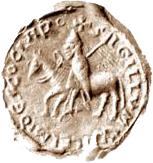Scotland
St. Clair family of Herdmanston
St. Clair family of Rosslyn
The history of the Sinclair family in Scotland is a subject of intense interest, especially after the publication of The Da Vinci Code. Sadly, this has continued a myth-making process that was started long ago by the Victorians. For sure, the Sinclairs made their mark on Scotland but they are not a Highland clan with a prehistory stretching back to early times. The first Sinclair was supposed to have arrived in Scotland from England around 1067, a consequence of the uneasy rivalry between the Scottish king Malcolm and William, the Norman conqueror of England. This was the story told by Jacob van Bassan and repeated by Father Hay in his genealogy of the Roslin St. Clairs about 1700. However, it is just as likely that, according to a contemporary chronicler, the St. Clairs accompanied King William ‘the Lion’ on his return to Scotland in 1174, following his imprisonment in Normandy.
Henry de St. Clair received land at Herdmanston in East Lothian from Richard de Morville prior to Richard’s death in 1189. Richard was Constable of Scotland and a strong argument has been made by historians that the appearance of St. Clairs in Scotland had much to do with the Morville family, who were acquainted with the St. Clair family in England and Normandy. Some years later, Henry received the barony of Carfrae in Lauderdale from Richard’s son, William, who had succeeded his father. At some point before William de Morville’s death in 1196, Henry deliberately resigned his interest in Carfrae back to William, who re-granted the barony of Carfrae to Alan St. Clair, Sir Henry’s heir, as a marriage gift on Alan’s marriage to Matilda de Windlesore (Windsor) daughter of Alexander de Windlesore, a prominent family from Westmoreland in England.
There were other St. Clairs noted in the few charters that still exist who appear contemporary with Sir Alan of Herdmanston and who may have been his younger brothers, such as Sir Robert and Sir John St. Clair. Both were adherents of the next power behind the throne in Scotland after the Morvilles; the Comyn family. Unfortunately the documentation to link each generation is sadly lacking, as is the ancestry of the first known St. Clair of Roslin.
There were a few early charters witnessed by men with the title of ‘de Roscelyn’ or Roslin but the first mention of a St. Clair in connection with the barony of Roslin was when Henry de Roscelyn resigned his barony back to the King, who then gifted the lands to William de St. Clair. The Roslin charter is dated 14 September 1279 and one of the witnesses to that charter interestingly, was William Comyn of Kilbride, continuing the Comyn connection.
William St. Clair was Sheriff of Edinburghshire (Edinburgh, Linlithgow and Haddington) in 1264, he was appointed Sheriff of Edinburghshire for life in 1271, and was also Sheriff of Dumfries in 1288. There are several entries in the Exchequer Rolls of Scotland mentioning William St. Clair as Sheriff, one in 1288, where he had claimed 18s. 4d. for the outlay on a garden and the wages of a gardener at Haddington, possibly his private residence, as he was paid but told in the future he would have to bear the costs of the garden out of his own income. On the basis that William was initially appointed as Sheriff covering the Haddington area in East Lothian (where Herdmanston also lies) in 1264, it is feasible he was appointed to cover his own home turf and, given the frequency of the name William in the Hermanston St. Clair family, that William was a member of their (by that date) extended family, although once again, the documents to establish it are lost.

